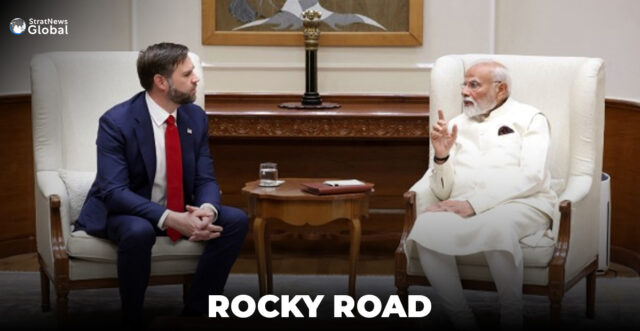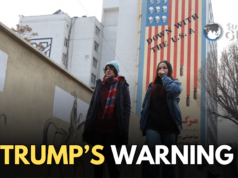The announcement of a trade roadmap drawn by Prime Minister Narendra Modi and visiting U.S. Vice President JD Vance in New Delhi was welcomed in Washington as a key breakthrough on Monday.
U.S. Trade Representative Jamieson Greer called the agreement “a critical step forward” toward achieving a Bilateral Trade Agreement (BTA) between two of the world’s largest democracies.
The new Terms of Reference aim to build a framework for reciprocal trade, tariff reduction, and expanded market access—language that signals high ambition.
But beneath the upbeat diplomacy lies a complicated path, shaped by old sticking points, political risk, and the return of Trump-era protectionism.
In 2024, bilateral goods trade between the U.S. and India reached $129.2 billion. Yet the U.S. ran a $45.7 billion trade deficit with India, up 5.1% from 2023—drawing the ire of President Donald Trump, who has once again made trade imbalances a political rallying point.
“On April 2, 2025, Liberation Day, President Trump imposed a 10% tariff on all countries and individualized reciprocal higher tariffs on nations with which the U.S. has the largest trade deficits in order to level the playing field,” says a USTR Fact Sheet on trade negotiations with India.
These moves were cast as part of the administration’s “America First” trade policy aimed at protecting U.S. jobs and manufacturers. But they’ve made trade negotiations with allies harder, not easier.
India’s high tariffs are a particular flashpoint. Its average applied tariff rate is 17%, with agricultural imports facing a steep 39% duty. In contrast, the U.S. maintains an average tariff of just 3.3%, and only 5% on agriculture.
American exporters, particularly in agriculture and dairy, have long sought more access to the Indian market. But in India, where over half the population is linked to agriculture, slashing duties on farm goods is politically fraught.
In a statement last week, Greer acknowledged that “significant trade barriers with India remain, including high tariffs, technical barriers to trade, and regulatory restrictions across services, industrial, and agricultural sectors.”
Adding to the tension is the ever-sensitive issue of immigration. Indian negotiators remain concerned about the future of the H1B visa program, which is critical for the country’s IT and tech workforce. While not officially part of the trade talks, the Trump administration’s prior clampdown on skilled visas—and potential plans for further restrictions—has created trust issues. Without assurances on immigration, India is unlikely to offer major concessions.
“Visas may not be in the fine print, but they’re very much on the table politically,” said a former Indian trade negotiator. “And without predictability, there’s little appetite for risk.”
Non-tariff and regulatory barriers compound the challenge. U.S. businesses cite India’s complex and often opaque rules around standards, testing, and certification as deterrents. Indian firms, meanwhile, face barriers in U.S. pharmaceuticals, digital services, and public procurement. These require deep, sustained negotiations to resolve—and trust that agreements won’t be unilaterally reversed.
That trust is what many fear could be lacking. Trump’s unilateralism in his first term—walking away from multilateral agreements, threatening allies with tariffs, and tying unrelated issues together—still looms large. For India, the fear isn’t just about tough negotiations. It’s about whether any deal will hold if U.S. politics swings again.
Trust-based negotiation becomes a high-risk game when one side could shift course with a social media post.
Still, the incentives are real. For the U.S., India is a crucial partner in efforts to diversify supply chains away from China and shape the rules of global trade. For India, access to U.S. markets and technology investment is essential for economic growth and strategic autonomy.
But aligning those interests into a durable, mutually beneficial trade pact won’t be easy—especially with volatile politics on both sides.
Some analysts, like Brahma Chellaney a geostrategist and author of nine books, including the award-winning Water: Asia’s New Battleground, argue that “Trump’s return to power is not merely restoring the U.S.-India relationship — it is revitalising it with fresh urgency, grounded in mutual interests and shared concerns.”
Others, however, insist that while the Modi-Vance trade roadmap offers a welcome push, a deal won’t come easy. And that it is far, far too early to break out the champagne.
In a career spanning three decades and counting, Ramananda (Ram to his friends) has been the foreign editor of The Telegraph, Outlook Magazine and the New Indian Express. He helped set up rediff.com’s editorial operations in San Jose and New York, helmed sify.com, and was the founder editor of India.com.
His work has featured in national and international publications like the Al Jazeera Centre for Studies, Global Times and Ashahi Shimbun. But his one constant over all these years, he says, has been the attempt to understand rising India’s place in the world.
He can rustle up a mean salad, his oil-less pepper chicken is to die for, and all it takes is some beer and rhythm and blues to rock his soul.
Talk to him about foreign and strategic affairs, media, South Asia, China, and of course India.





